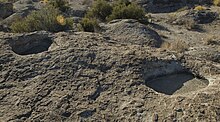
A tinaja [tiˈnaxa] is a surface pocket (depression) formed in bedrock that occurs below waterfalls, that is carved out by spring flow or seepage, [1] or that is caused by sand and gravel scouring in intermittent streams (arroyos). [2] [3] Tinajas are an important source of surface water storage in arid environments. [2] [4]
These relatively rare landforms are important ecologically, because they support unique plant communities and provide important services to terrestrial wildlife. [5]
The term originates in Spain, being Spanish for "clay jar", and is used in the American Southwest.
Examples
- The Tinajas Altas ("high tinajas") in southern Arizona.
- Several in El Pinacate y Gran Desierto de Altar Biosphere Reserve, Sonora, Mexico.
- Las Tinajas de Los Indios, California
- Las Tinajas, Zinapécuaro, Mexico
- San Estaban Dam on Alamito Creek at the tinaja in Presidio County, Texas
References
- ^ Osterkamp, W. R. 2008. Annotated Definitions of Selected Geomorphic Terms and Related Terms of Hydrology, Sedimentology, Soil Science and Ecology: Reston, Virginia, Open File Report 2008-1217, pp 49
- ^ a b Fox, William (2005). Desert Water. Portland, Oregon: Graphic Arts Center Publishing Company. p. 12. ISBN 978-1-55868-858-2.
- ^ Mabbutt, J. A. (1977). Desert Landforms. Canberra: Australian National University Press. p. 182. ISBN 978-0-7081-0437-8.
- ^ Brown, T. B. and R. R. Johnson. 1983. The distribution of bedrock depressions (tinajas) as sources of surface water in Organ Pipe Cactus National Monument, Arizona. Journal of the Arizona-Nevada Academy of Science 18: 61-68.
- ^ National Park Service (NPS). 2006. Organ Pipe Cactus National Monument Ecological Monitoring Report, 1997–2005, Chapter 14: Water Quality. http://www.nps.gov/orpi/naturescience/orpi-ecological-monitoring-report.htm
External links
![]() The dictionary definition of
tinaja at Wiktionary
The dictionary definition of
tinaja at Wiktionary